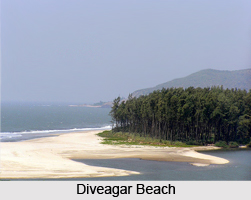 Diveagar, situated in the Shrivardhan Taluka of Raigad district in the Indian state Maharashtra, is a locale known for its gorgeous beach that serves as a cherished tourist spot. It is located at a distance of about 170 kilometres from Mumbai and includes a temple, a beach, a fishing settlement and local businesses engaged in coconut and betel nut tree farming. There are six villages namely Karle, Borlai Panchaitan, Diveagar, Agar Panchaitan, Musalmandi and Velas. Diveagar beach is quite secluded and its white shimmering sands, blue water and resplendent serenity are worth experiencing.
Diveagar, situated in the Shrivardhan Taluka of Raigad district in the Indian state Maharashtra, is a locale known for its gorgeous beach that serves as a cherished tourist spot. It is located at a distance of about 170 kilometres from Mumbai and includes a temple, a beach, a fishing settlement and local businesses engaged in coconut and betel nut tree farming. There are six villages namely Karle, Borlai Panchaitan, Diveagar, Agar Panchaitan, Musalmandi and Velas. Diveagar beach is quite secluded and its white shimmering sands, blue water and resplendent serenity are worth experiencing.
History of Diveagar
History of Diveagar is quite old. Evidences of the presence of more than five hundred years old settlements have been found in Diveagar. The village had encountered attacks by the Arabs, the Portuguese and the Mughals since thousand years. Owing to repeated attacks, the entire village had been demolished about 3 to 4 times.
Diveagar Beach
The beach of Diveagar is set along the Arabian Sea and stretches to about four kilometres. The place is quite undeveloped. A small stream merges with the ocean at the north end of the beach. It also shelters a fishing settlement along with some paddy farming. The southern end of the beach hosts a sanctuary for migratory seabirds. A small fishing village is located nearby which is popular as Bharadkhol. A number of Casuarinas dot the beach which is a common sight in the coastal regions of Maharashtra. A thick cover of Belu trees can be found on the way to the beach; however these trees are otherwise rare in this region. People from nearby towns of Shrivardhan and Harihareshwar often visit the beach for spending a refreshing time. Diveagar hosts a number of sand bubble crabs. Visitors can also have a magnificent sight of dolphins at the nearby Harihareshwar beach. Sea turtles can be seen laying eggs in the beach.
Diveagar Ganpati Temple
Diveagar also houses a Ganpati temple which previously had a golden idol of Lord Ganesha. However on 25th March 2012, the idol was allegedly stolen by thieves and was later melted. The golden idol had a weight of about 8 kilograms. Since then, the idol of the temple has been replaced by another idol made of silver.



















